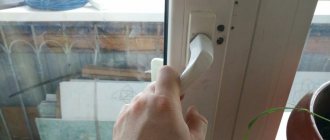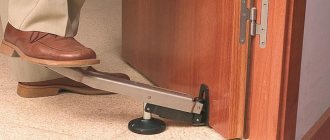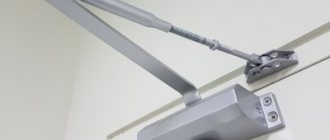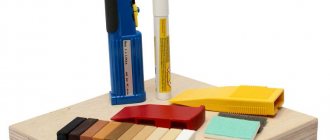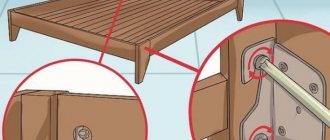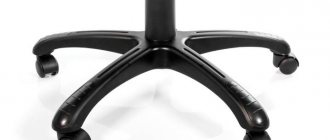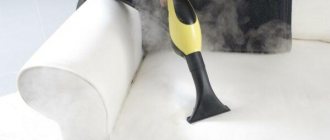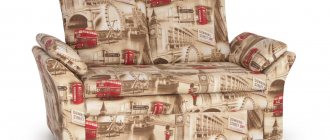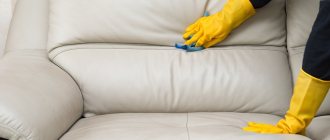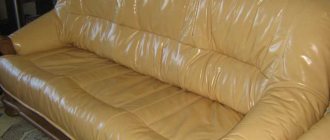Leatherette items serve their owners for a long time, but after some time, cracks or small scratches appear on them. A small crack can soon become a big hole. Such damage spoils the appearance of the item and renders it unusable. Therefore, the service life of this product is significantly reduced. Let's talk about possible options for repairing leatherette products.
“Liquid” leather for repairing leather products: reviews, advantages
Despite the successes of the petrochemical industry, which supplies us with synthetic products, in life we are still surrounded by products made from natural materials, including genuine leather. This material is highly susceptible to various mechanical influences. Even a small dog can seriously scratch a new leather sofa, and it's very frustrating. A scratch on a brand new leather jacket or shoes is no less frustrating. Everyone knows this. With “liquid skin” these problems will disappear.
Previously, in such cases, people went to workshops where specialists offered repair services. This took a lot of time and money. Today, with the help of modern technologies, you can carry out minor repairs to leather products right at home. “Liquid leather” for repairing leather products will help with this. Reviews of this material indicate the high effectiveness of funds in this area.
Required materials and tools
To choose the right materials, you should carefully evaluate the condition of the furniture. This is necessary to understand the nature of the problem and determine how to fix it. To repair leather furniture, you may need professional tools that are not advisable to buy for one-time home use.
If we are talking about simple contamination, then it will be enough to prepare a cloth and alcohol. Repairing cracks is a little more complicated. Before starting work, you will need to acquire construction tools - they will be used to dismantle furniture and remove old upholstery.
This is a set of screwdrivers, wrenches, screwdriver, pliers, staple removal tool. Changing the material involves using a staple gun. This is a basic set of tools.
There are repair options using paint, liquid leather and other improvised means. Therefore, it is worth purchasing them in advance. Don't forget about the sofa's filling - the material may also need to be fully or partially restored. Foam rubber is often used as a filler. You definitely need to get some thread and a needle. A sewing machine will do the job faster. If you plan to partially or completely replace the upholstery, then a large amount of new material will be required.
Leatherette sofa repair: it all depends on the scale of the problem
The first thing to do is to assess the scale and nature of the damage. Typically, people need to tidy up their sofa upholstery for the following reasons:
- spots appeared on it;
- cracks, scratches or tears have appeared on it in one or two places;
- it had completely fallen into disrepair - it was worn out, large holes formed on it.
It is quite easy to deal with stains, scratches and small tears on a sofa made of leather, both natural and artificial. But doing a complete re-upholstery yourself is more difficult.
Scratches
If you don’t know how to save your sofa or chair from scratches, then you can safely rush to the store for rubber glue. It is applied to the scratches, wait until it is completely dry, and then the defect area is painted with a special cream that matches the shade of the upholstery. The main thing is to ensure that the rubber glue does not contain acetone. Because it tends to corrode leather fabric.
What to do if your eco-leather jacket is cracked?
Has your favorite jacket lost its former shine, and has scuffs, creases and other damage appeared on the surface? How to restore a leather jacket - let's take a closer look at your next steps:
- Assess the extent of damage. This must be done first of all so that you understand what kind of repair the product needs and how much time it will take. First of all, you need to inspect the jacket; if there is severe damage on its surface, then to restore it you need to use deep dyeing products, and the repair process itself will be painstaking and long.
Important! Small scratches on artificial leather should be removed immediately after they are identified. This must be done to further preserve the item and protect it from more serious damage to the material.
- Do the repairs yourself. It is advisable to do such actions only in case of minor defects on eco-leather. If you decide to restore severely damaged leatherette on your own, then you risk damaging the product.
- Use the services of qualified specialists. The best way out of this situation is to contact a professional. This is due to the fact that working with natural and artificial materials requires special care, skills and adherence to restoration technologies.
Restoring the appearance of shoes with cracks in leatherette
To repair such shoes, we buy vinyl leather. This is a synthetic piece of fabric coated with polyvinyl chloride. Unfortunately, in this way it will be possible to repair only isolated damage. If your shoes have a lot of cracks that have burst, you will have to replace them with leatherette. Also, a single damage can be repaired by applying a special patch to it, which can be purchased at a fabric store.
Important! In order for the work to be of high quality, when performing repairs, it is necessary to adhere to a certain technology.
Methods for repairing various defects on eco-leather
Carefully examine the thing you are going to restore, determine the type and scale of the “disaster”. You can repair an eco-leather product in different ways. Which one depends on the type of damage. Let's take a closer look at them.
Stains, abrasions, microcracks
If the upholstery has acquired an unkempt, dull appearance over time, then it must be thoroughly cleaned of stubborn dirt and stains. For deep cleaning, use concentrated soapy water, then wipe dry and gently treat with 70% alcohol or wine vinegar.
Grease stains are effectively removed by dishwashing gel: apply it to the stain and leave for 2-3 hours, then remove with a damp cloth.
You can get rid of old stains using gasoline: apply a little of it to a soft sponge, lightly rub the stain and leave for 30-40 minutes. Remove with a sponge soaked in soapy water.
You can renew worn upholstery on a sofa, ottoman, armchair or car, as well as get rid of cracks using several means:
- Olive oil. You can take the cheapest one. Apply the oil to the damaged area and rub it in using a cotton pad in a circular motion. Wait 1-1.5 hours until the oil is completely absorbed. Evaluate the result and, if necessary, repeat the procedure.
- Shoe polish. Colorless will add shine, colored will paint over minor scuffs. It is important to choose a cream that exactly matches the color of the product and, after painting, wait until it dries completely.
- Permanent marker. Its ink is highly water resistant. Clean the surface from dirt. Carefully outline the microcracks with a marker that exactly matches the color of the product. Wait 20-30 minutes. It can be applied in several layers.
- Pigmented varnish. Suitable for eco-leather with a glossy finish. Rare shades, for example, very bright ones, are obtained by mixing primary colors. Apply to a degreased surface.
- Special paint. Carefully select the tone - if you don’t find the perfect match, take a tone a little darker. Before painting, degrease the fragment with alcohol. Spray aerosol paint with smooth movements at a distance of 20-30 cm, apply the composition from the jar with a slightly moistened foam sponge, patting. The applied layer must be very thin to avoid cracks. Try not to paint “healthy” areas of the surface; if smudges form, remove them immediately with a dry sponge. After drying, the paint can be reapplied.
Try to remove stains on eco-leather immediately. To prevent abrasions and microcracks from appearing on it for as long as possible, regularly wipe it with care products - waxes, oils, polishes. This will not only protect the product, but will also repel dust and dirt from it.
Scratches, punctures, snags
Scratches and snags are damage to the top layer of material. They are often left by cats. To get rid of scratches and punctures, you can use the following tools:
- Nail polish. After cleaning, carefully apply the polish in a very thin line. You can take transparent or close to the color of the coating. For a matte surface - matte varnish, for a glossy surface - regular.
- Furniture touch. The method of action resembles a clerical touch. You can find it in specialized furniture stores. Shake the bottle vigorously before use. Apply it in 2-3 layers using a brush. Wait until it dries completely, then wipe the treated area with a soft, damp cloth.
- Furniture wax. It can be soft and hard. Simply rub the scratches with soft wax. If there are a lot of them and they are large, then use a spatula or a regular kitchen knife. Leave for 15 minutes, carefully remove excess. Polish the treatment with a cotton cloth. Hard wax is more practical and stable, but working with it requires skills. First you need to melt it, then treat the scratch itself and the area around it. This must be done quickly, since hard wax hardens within a minute. Finally, the treated area should be sanded well with a flannel cloth.
Another special product for masking scratches is a colored furniture pencil. It is effective, but does not last long - it must be constantly updated.
Cuts, cracks
Cuts and cracks are more complex damage than surface snags, since they affect the entire structure of the material, right down to the filling of furniture or car seats. To eliminate the defect, you can use superglue or universal leather glue. Apply it to the crack with a toothpick or match. Then press the edges tightly for a few seconds. Wipe off excess glue immediately. If the glue is noticeable, polish it and use paint.
If the defect is very large, then glue alone will not be enough - you will have to install an internal patch. Use eco-leather that is identical in texture, and if you are going to paint the patch, it does not matter what color it is. Using tweezers, insert the patch under the cut and straighten it out. Sand the back side with grit sandpaper - this will enhance adhesion. Using a thin stick, apply glue to the underside of the eco-leather around the cut and, aligning the edges, press firmly with your hand. To ensure everything sticks exactly, place a weight on the patch for 1 hour. If necessary, polish and paint.
Gaps, holes
If eco-leather upholstery has been seriously damaged, for example, a cigarette hole has appeared, or a tear with torn edges, then the optimal restoration is repair with a unique camouflage agent “liquid leather”. It contains glue, coloring matter, and rubber resin. It restores glossy and matte textures equally well.
Repair gaps using a polymer mixture as follows:
- Level the damaged surface, cut off protruding pieces, fibers, and severely deformed areas.
- Wipe the surface with liquid detergent, degrease, and dry.
- Glue the places where the edges meet. For large holes, apply internal patches as described above in the “Cuts” section.
- Sand when the glue is completely dry.
- Apply the prepared composition with a brush of a convenient size or a piece of foam rubber. The required shade can be created by mixing the base tones of the product. During application, smudges may form - you can remove them and level them with a regular ruler or a flat and hard object similar to it. The first layer should be the thinnest. After 2-3 hours you can apply a second one.
- Do not use the restored product until the mixture has dried - 24 hours.
- Polish with a soft cloth. If the treated fragment lacks shine, then coat it on top with a transparent or pigmented varnish.
You can also make “liquid skin” yourself. To do this, take a piece of leather that is close in shade to the product you are repairing. Place 1-2 drops of acetone solvent on the outer surface of the piece. Scrape off the peeling paint with a knife blade - this will be the substance you are looking for. Use it as intended.
When applying liquid special agents to large areas, the most important thing is to recreate a relief “skin” pattern. To do this, we recommend treating small defects with a brush - it will help add texture. And for fragments larger than 2 cm², use a template napkin. It is created like this: a restoration agent is applied to a regular napkin, applied to a “healthy” surface with a clearly visible pattern, and dried. Then, with this “template” you can create natural unevenness during subsequent repairs of eco-leather.
There are defects that cannot be masked by any special compound: large “creeping” cracks, holes. Such areas can be repaired using overlays or appliqués that are placed on top of the upholstery. You need to understand that they will greatly change the appearance of furniture or car seats, but will help stop further growth of tears. When deciding on the shape and color of the stripes, show your imagination. Contrasting abstract patterns or concrete images look original. Place external artistic patches on glue, after degreasing the damaged area.
Do not try to sew up very cracked eco-leather with thread and needle. Firstly, it looks sloppy. Secondly, a needle, even the thinnest one, will leave punctures and provoke new ruptures.
Restoring eco-leather is a painstaking, almost jewelry-like process. To make you happy with the result, carry out repairs in a timely manner - do not wait until a small puncture becomes a big hole.
Tears or holes
If your furniture has been damaged by a cigarette burn, or has been torn and now has uneven edges, “liquid leather” will help. This substance can be found in a repair kit for leather furniture, but if you don’t have such a kit, you can buy it separately. Liquid skin looks like a creamy paste and is applied with a small spatula. After the mass dries, the substance becomes similar to an elastic film and is practically no different from the coating of furniture.
Manufacturing process
Eco-leather is a two-layer material , the bottom layer of which is made of fabric, and the top layer is a layer of polymers; they give the appropriate texture and the desired color. Cellulose, polyethylene, rubber, and protein substances are used to make the polymer layer. The United States was an innovator in the production of eco-leather, and soon Japanese specialists began to develop developments in this direction.
Most often, the following materials are used for the base :
- cotton is a natural fabric obtained from cotton;
- polyester is a synthetic fabric made from polyester fibers.
The top layer is best made from pouleritan, a rubber substitute. The bulk of it in industry is used for the production of shoe soles and car tires. This material is also used in the production of glue, sealant, paints and the like. The advantage of polyurethane is its high wear resistance and durability.
In its structure, this material has a porous structure and allows air to pass through , which improves the properties of eco-leather. In addition, polyurethane eco-leather is completely safe and free of chemical odor. The characteristic “leather” pattern on the surface of the material is obtained under high pressure. You can distinguish eco-leather from natural leather by the reverse side of the product. The woven base immediately reveals its artificial origin. In addition, eco-leather cannot be warmed up with the warmth of your hand; it always remains cold.
Restoration of the upper protective layer
Over the years, furniture may develop bald spots or voluminous scuffs that cannot be corrected with paint. In this case, restoration masks should be used. Their essence lies in the fact that they are applied over the entire surface of the product, and not locally. Before applying a protective mask, the entire surface of the furniture should be treated, cleaned of dirt, dried, then sanded with a special sanding sponge, after which the upholstery should be degreased.
In essence, such masks resemble paint, but have a deeper and longer-lasting effect. After restoration with a restorative mask, your furniture will have its previous appearance for 2.5 - 3 years.
How to restore eco-leather on a sofa
Leather furniture looks impressive and stylish. People are increasingly refusing to buy expensive sofas and armchairs upholstered in natural leather due to high costs and ethical principles. An inexpensive alternative has become eco-leather, which in appearance is practically no different from natural leather, and in some respects even surpasses it.
Liquid leather is rightfully considered the best material for the restoration and restoration of ecological leather. The polymer material fills cracks, cuts, marks from teeth and claws.
Restoration work is carried out in several stages:
- the surface is leveled, threads and fibers are removed;
- the edges of the cut or hole are carefully stitched or glued from the inside;
- eco-leather is wiped with liquid detergent and dried;
- the desired shade is selected by mixing several basic colors;
- liquid skin is applied with an art brush or foam rubber;
- The repaired sofa is left to dry for a day.
How not to ruin your sofa completely
If abrasions and damage occupy a large area, then the furniture cannot be restored. It is also unlikely that a sofa upholstered in eco-leather in an exotic color (light green, turquoise, coral, terracotta, lilac) will be able to return to its original appearance. At home, it will not be possible to recreate a complex and ornate design using a napkin or a piece of old leather.
A little about the choice of materials for repairs
The leader among manufacturers of restoration pastes is the French company Saphir. Restoring cream extends the service life of damaged, worn and discolored products. The product is suitable for smooth surfaces; when applied, it creates a durable and elastic layer that repels water. Saphir does not stain clothes and dries quickly.
If you find scratches on leather furniture, clothes or shoes, you should not be upset. There are effective ways to remove imperfections from leather surfaces at home.
Moreover, in some cases there is no need to purchase expensive ingredients; it is enough to know the properties of the products at hand.
This product belongs to professional restoration, it is reliable and effective.
Using liquid leather, otherwise called water-soluble polymer, you can get rid of scratches, abrasions, cracks, cuts and even tears on a bag, clothing or any other product.
The composition of the product is similar in consistency to gouache, so there are no difficulties with restoration.
Apply a thin layer of water-soluble polymer to the damaged area, then apply pressure with a dry sponge to create relief. Leave to dry. If the result is not satisfactory, then the procedure should be repeated.
We do shoe restoration this way.
- We determine the amount of damage. You need to run your hand over the defect. When the roughness is felt only as you move in one direction, the material itself is damaged; if in different directions, only the paint is damaged.
- You need to remove the protruding pieces with nail scissors or tweezers, then smooth out the damaged area with any gentle fine abrasive (manicure buff). Don't rub too hard.
- We clean the area with alcohol or a special composition.
- Apply liquid skin to the defect. The main thing is to accurately select the shade of the polymer. Distribute the product evenly over the entire damaged area so that the transition is invisible. Leave for 15 minutes. Polish. If one treatment was not enough, then liquid skin can be applied two or three more times. Each layer must be allowed to dry for fifteen minutes before applying the next!
- Treat the damaged area with milk or balm.
If the damaged surface was processed correctly and the color of the polymer was chosen correctly, the result will exceed all expectations: there will be no trace of the defect.
The setting time of the water-soluble polymer is from 10 minutes to half an hour. Final drying occurs after 24 hours.
There is a commercially available water-soluble polymer designed specifically for varnished surfaces.
Step-by-step instructions for use
It is best to treat cuts not with glue, but with liquid putty
Repairing leather furniture with your own hands is a simple process, but quite responsible. Below are detailed instructions on how to repair a leather sofa.
Instructions for using liquid leather for cutting furniture
- First of all, it is necessary to clean the damaged area from broken fibers and glue the edges of the crack or tear. To achieve the best results, the crack can be sewn up in several places, and the hole can be pre-sealed from the inside.
Damage to furniture upholstered in light leather
- Degrease the surface of the leather sofa with detergent and dry thoroughly.
Washing a leather sofa before restoration
- Choose the right color for “liquid skin”. If you need to choose a complex color scheme, the kit includes a special table of colors and tones. With their help, you can determine the color scheme that needs to be mixed to obtain the desired shade.
If the cut is deep, you need to glue the inside or make a patch
Table of liquid leather color combinations for the product
- Apply the mixture to the prepared area of the leather sofa. This can be done with a brush or a piece of foam rubber.
Applying liquid skin with a spatula to damaged areas
- Smooth the layer of product applied to the damaged surface of leather furniture. If you don’t have a spatula at home, you can do this with an unnecessary ruler or plastic card.
Upholstery looks better after the second coat
- Remove any contact with the repaired area before the mixture is completely dry.
Useful notice. To give the repaired area a porous pattern that matches the entire surface of the leather sofa, it is necessary to glue a piece of leather (natural or artificial) of the appropriate texture to the surface being treated and press firmly for a few seconds.
In the absence of a fragment of fur, you can create your own template from an ordinary paper napkin. To do this, a layer of the mixture is applied to it, and the napkin is applied to the undamaged area, where the relief appears especially clearly. After this, the resulting stencil should dry completely. Used in the same way as in the first option.
The result of wearing liquid skin with before and after photos
There are times when, when restoring leather furniture, the result obtained does not live up to expectations. This is mainly due to the following reasons:
- the leather sofa has a large defective area;
- wrong skin tone;
- ignore the recommendations established in the instructions for use of the product;
- The pattern of the piece of leather used for embossing does not match the overall texture of the surface of the leather sofa.
The result of the correct color of liquid leather for repair
How and with what to clean a leather sofa at home - 12 ways
Leather furniture looks impressive and is a decoration for any room. There is only one problem - not everyone knows how to wash this furniture correctly so as not to spoil the appearance. It is worth considering all the nuances of cleaning a leather sofa and the rules for caring for it.
Sources
- Puzakov S. Ya. Personnel Directory, in 2 volumes. T. 2; Prometheus - M., 2022. - 448 p.
- Daria Mikhailovna Moshkova Educational and scientific organizations as subjects of financial law; Prospect - M., 2012. - 450 p.
- Irina Anatolyevna Alabastrova Constitutionalism as a legal basis for social solidarity. Monograph; Prospect - M., 2009. - 815 p.
- Citizen and Law No. 08/2011; Gostekhizdat - Moscow, 2011. - 510 p.
- Lovtsov Dmitry Systemology of legal regulation of information relations in the infosphere; Gostekhizdat - Moscow, 2022. - 394 p.
Care method
The structure of the material consists of two layers:
- microporous polyurethane film with a printed surface of natural composition on the top layer;
- polyester base.
The combination ensures ventilation and moisture permeability. Therefore, product care is carried out quickly and without special costs.
You have these rules on how to care for eco-leather on furniture:
- avoid strong friction of the upholstery, do not press intensely;
- wipe with slightly damp towels so that excess moisture does not penetrate between the layers;
- Place sofas and armchairs made of this material away from sources of heat and light.
On a note! Use soft rags for cleaning. Polishing is allowed with products intended for genuine leather. Rub the surface once a year with a water-repellent preparation.
